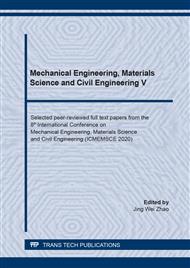[1]
Mohanraj Murugesan, Dong Won Jung, Two flow stress models for describing hot deformation behavior of AISI-1045 medium carbon steel at elevated temperatures, Heliyon, 5 (2019) e01347.
DOI: 10.1016/j.heliyon.2019.e01347
Google Scholar
[2]
Murugesan. M., Jung. D.W, Johnson-Cook Material and Failure Model Parameters Estimation of AISI-1045 Medium Carbon Steel for Metal Forming Applications. Materials 2019, 12, 609–627.
DOI: 10.3390/ma12040609
Google Scholar
[3]
Mohanraj Murugesan, Muhammad Sajjad, Dong Won Jung, Hybrid Machine Learning Optimization Approach to Predict Hot Deformation Behavior of Medium Carbon Steel Material, Metals, 9, 1315, (2019).
DOI: 10.3390/met9121315
Google Scholar
[4]
Mohanraj Murugesan, Muhammad Sajjad, Dong Won Jung, Microstructure Evaluation and Constitutive Modeling of AISI-1045 Steel for Flow Stress Prediction under Hot Working Conditions, Symmetry, 12, 782, (2020).
DOI: 10.3390/sym12050782
Google Scholar
[5]
Lee. K, Murugesan. M, Lee. S.M. and Kang. B.S, A Comparative Study on Arrhenius-Type Constitutive Models with Regression Methods, Trans. Mater. Process. 2017, 26, 18–27.
DOI: 10.5228/kstp.2017.26.1.18
Google Scholar
[6]
Y. H. Wang, J. H. Jiang, C. Wanintrudal, C. Du, D. Zhou, L. M. Smith, and L. X. Yang, Whole field sheet-metal tensile test using digital image correlation. Experimental Techniques, (2010).
DOI: 10.1111/j.1747-1567.2009.00483.x
Google Scholar
[7]
Miroslav Tomas, Emil Evin, Jan Kepic and Juraj Hudak, Physical Modelling and Numerical Simulation of the Deep Drawing Process of a Box-Shaped Product Focused on Material Limits Determination, Metals, 9, 1058, (2019).
DOI: 10.3390/met9101058
Google Scholar
[8]
Praveen R. Samala, Y. H. Wang, Z. Zhu, D. Zhou, W. Yang, C. Du, L. M. Smith, and L. X. Yang, Measurement of Strain Localization in a Tensile Test Using Full Field Optical Technique - Digital Speckle Correlation, SAE Technical Papers, (2008).
DOI: 10.4271/2008-01-0682
Google Scholar
[9]
Kaishang Li, Jian Peng, and Jian Peng, Mechanical Behavior of 316L Stainless Steel after Strain Hardening, MATEC Web of Conferences 114, 02003 (2017).
DOI: 10.1051/matecconf/201711402003
Google Scholar
[10]
Yajun Chen, Chunming Ji, Changtian Zhang, and Shengjie Sun, The Application of DIC Technique to Evaluate Residual Tensile Strength of Aluminum Alloy Plates with Multi-Site Damage of Collinear and Non-Collinear Cracks, Metals, 9, 118, (2019).
DOI: 10.3390/met9020118
Google Scholar
[11]
Dan Zeng and Z. Xia, White, Extending Tensile Curves beyond Uniform Elongation Using Digital Image Correlation: Capability Analysis, SAE Int. J. Mater. Manuf., 3(1), (2018).
DOI: 10.4271/2010-01-0981
Google Scholar
[12]
N. Hedayati, R. Madoliat and R. Hashemi, Strain measurement and determining coefficient of plastic anisotropy using digital image correlation (DIC), Mechanics and Industry 18, 311 (2017).
DOI: 10.1051/meca/2016060
Google Scholar
[13]
Jin-Hyuk Lee, Gwang-Hee Kim, Su Kwon Nam, Insoo Kim, Dong Nyung Lee, Calculation of plastic strain ratio of AA1050 Al alloy sheet processed by heavy asymmetric rolling–annealing followed by light rolling–annealing.
DOI: 10.1016/j.commatsci.2014.09.049
Google Scholar
[14]
Murugesan. M., Kang. B.S. and Lee. K, Multi-Objective Design Optimization of Composite Stiffened Panel Using Response Surface Methodology, J. Compos. Res. 2015, 28, 297–310.
DOI: 10.7234/composres.2015.28.5.297
Google Scholar
[15]
Mohanraj Murugesan, Muhammad Sajjad, and Dong Won Jung, Experimental Investigations on Incremental Sheet Forming of Commercial Aluminum Alloys for Maximum Production Quality, International Journal of Mechanical Engineering and Robotics Research, 9(9), (2020).
DOI: 10.18178/ijmerr.9.9.1264-1270
Google Scholar
[16]
Mohanraj Murugesan, Muhammad Sajjad, and Dong Won Jung, Formability evaluation of aluminum alloy sheets in incremental sheet forming process using various forming parameters, International Journal of Mechanical and Production Engineering Research and Development (IJMPERD), 10(3), 6621-6632, (2020).
DOI: 10.18178/ijmerr.9.9.1264-1270
Google Scholar


